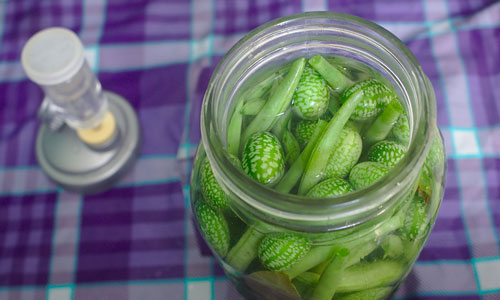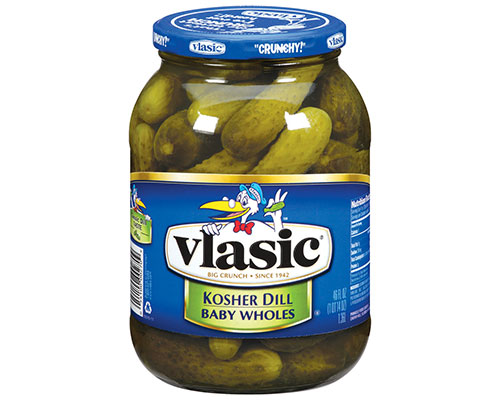Who Doesn’t Love Pickles?
Generally dill-flavored, always salty, and often found in iconic Jewish delis, the pickled cucumber is an icon of strong flavor. (As is pickle juice.)
Editor's note: Before we go any further, I wanted to give a major shoutout to one of our readers. Herbert Jacobi made a generous donation in support of our little newsletter. If you'd like to follow suit, you can chip in over at our Patreon page. Thanks again, Herbert!
2030
The estimated year (in BC, of course, since we haven’t hit 2030 in AD yet) in which cucumbers were first pickled, according to PBS’ The History Kitchen. The belief is generally that the food came from India, though the name of the process is said to come from either the Dutch or German words for “salt” or “brine.” In the pre-refrigeration days, pickling was an essential way to preserve food for storage. The process is closely associated with Jewish food due pickled foods being used by Eastern European Jews to get flavorful food during the cold winter months. (They sure beat bread and potatoes.)

Mexican sour gherkins, a variation of pickle that's become buzzworthy in recent years, mixed with pickled green beans. (SoFuego/Pixabay)
Five interesting details about pickles you should ferment in your brain
- Pickles are one of the most calorie-light foods that you can buy in the store. A single dill pickle spear has just four calories—something largely due to the fact that cucumbers are generally considered to be incredibly low-calorie. The brine doesn’t add any calories, but it does add a lot of sodium, which makes it a bit of a wash as a healthy nutrition source. (On the other hand, some athletic trainers swear by pickle juice as a way to prevent cramps, so it has that going for it.)
- The reason pickle jars are often difficult to open is due to the air pressure of the vacuum seal. That creates a high amount of pressure, which means you have to work to twist extra hard. This video helps to explain the science behind the problem, while this clip offers an overview of the various jar-opening techniques out there.
- “Bread and butter” pickles—a variety that tastes sweet and sour, rather than like bread and butter—got their name essentially because the variety’s popularizer, Cora and Omar Fanning, gave their pickles away to a local grocer in exchange for bread and butter.
- The process of pickling can be done with just a plastic syringe, strangely enough. Over at Instructables, the Oakland Toy Lab explains an alternative pickling strategy that takes just 30 seconds—and a little science.
- Tiny gherkins simply come from a different part of the traditional cucumber family, one that grows extremely undersized. The most interesting variant is the Mexican sour gherkin, which looks like a tiny watermelon. Modern Farmer calls it “adorable, delicious, and easy to grow.”
“Some of you like pickles. I get that. But you are not decent people, at least not if you think it’s OK for a restaurant to force pickles upon those of us whose stomachs turn at the mere sight or—worstly—smell of those squishy, acidic intruders.”
— Brian Hickey, a writer for Philly Voice and a man who has strong opinions about pickles. Hickey wrote a long rant about how awful pickles are, particularly emphasizing his frustration that they’re a default option with many sandwiches. “The onus should NOT be on we noble warriors to explicitly request our plates be pickle-free,“ he stated. When asked if he saw any positives about pickles, he simply responded, “nope.” Some people love pickles, others hate ‘em. We fall firmly in the “love” camp.

Vlasic Pickles, aka the Best Tastin' Pickle I Ever 'Hoid. (handout)
How Vlasic used marketing to dominate the U.S. pickle industry
The interesting thing about pickles is that, for decades, it was largely treated as a regional phenomenon in the United States—a family-owned thing that wasn’t really encumbered by advertising. Unlike the cheese curl, they didn’t immediately go national.
That left an opening for a big brand like Heinz to own the market, and there was a period where they were relatively dominant. But in the early 1970s, Vlasic, which started out as a family-owned firm, made a big play—a play that redefined the industry and made pickles as important a part of every pantry as cereal or baking soda. Before the Michigan-based company came along, pickles in many cases were a strongly regional product, sold in much the same way as milk.
But with the company’s factories growing along with its fortunes, it was able to take its Polish-style pickles national in part through well-considered manufacturing strategies—for example, pickles that were too large to be used whole in traditional jars would get reused in other contexts, like relish or as dill spears.
“If you buy a farmer's crop, you get a mixture of cucumbers. You have to use it all. It's like the meat business, where they use all of the pig except the squeal,” explained Bob Vlasic, the longtime head of Vlasic and son of company founder Joseph Vlasic, explained in a 1973 Detroit Free Press article.
A big element of Vlasic’s growth was its decision to advertise—a bit of a change from most of its competitors, the largest of which, Heinz, effectively treated its pickle business as a sidebar to the main condiment business. According to a Funding Universe analysis, Vlasic and Heinz each held around 10 percent of the national pickle market in 1970. Around that time, Vlasic introduced its popular animated stork mascot.
Why a stork? Credit an old wives' tale. The company decided to play off the idea that pregnant women crave pickles and created a mascot with a wink and a nod—something highlighted by this commercial.
Eventually, the company gained the slogan, “the pickle pregnant women crave.”
The company’s clever marketing helped it blow past Heinz—while the condiment-maker stayed at 10 percent of the market in 1977, Vlasic’s share of the pickle market grew to a quarter.
But Vlasic has had its share of ups and downs since. In 1978, beset by the price of pickles, it sold itself to Campbell’s Soup, in one of the soup-maker’s largest-ever acquisitions. Two decades later, Campbell’s spun it off, and in 2001, the company filed for bankruptcy.
Initially, it looked like Heinz, which had lost its footing against Vlasic in the pickle aisle, would swoop in, but a new buyer took over and was able to use the firm as a centerpiece of a new food empire, Pinnacle Foods. Pinnacle itself was acquired by Hillshire Brands in 2014.
The stork is still around, but maybe not as prominent as it once was. (It only has roughly 35 more Twitter followers than I do.)
But for a brief time in the 1970s, Vlasic turned pickles into a buzzworthy product by marketing the hell out of them.
"Most of our competitors were manufacturing oriented, generations of fine pickle makers and proud of it,” Bob Vlasic told Forbes in 1997. “We came in exactly the opposite, as marketers who manufactured to have something to sell."
“Who was that pickle-o I saw you with last night? That was no pickle, that was my fife!”
— One of the jokes included in Bob Vlasic’s 101 Pickle Jokes, a joke book sold by Pyramid Communications in 1974. The book, credited to the Vlasic head, featured illustrations from well-known cartoonist Don Orehek. According to a 1975 mention of the book in Cosmopolitan, the title had sold 250,000 copies in its first year. People in the ‘70s loved cheesy pickle jokes, apparently.
The industry stagnation that led Vlasic to take over the pickle aisle in the ‘70s hasn’t really faded away. Pickles are tasty, but kind of boring. The pickle sector is mature. It’s hard to make a mass-market pickle hip.
Reflecting that, the leaders in the market, including Heinz and Claussen, haven’t really done a lot to move the pickle forward in the past few decades.
But there has been some attempts at evolution in the pickle market, including, as any hipster would tell you, at the artisanal level. Firms like Brooklyn Brine have experimented with offbeat cukes like the Off-Centered Beer Pickle (which, excitingly, infuses Dogfish Head 60 Minute IPA into its pickles) and with highly ethical business approaches, like paying its workers $16 an hour.
High-priced pickles have been easy to mock, but some, like NPR reporter Adam Davidson, have been quick to defend the firms’ business acumen.
“Instead of rolling our eyes at self-conscious Brooklyn hipsters pickling everything in sight, we might look to them as guides to the future of the American economy,” Davidson write in a 2012 New York Times Magazine essay. “Just don’t tell them that. It would break their hearts to be called model 21st-century capitalists.”
In the case of Heinz, at least, they appear to be noticing the desire for a cuke rethink. Last year, the conglomerate—which has attempted to move beyond dill with two new flavors—Spicy Garlic and Sweet & Spicy.
A driving factor behind this shift, reports the Pittsburgh Post-Gazette, is segment stagnation. Despite pickles being a $1 billion business, the segment isn’t growing.
As steeped in tradition (and salty vinegar) as pickles are, the question naturally arises: Do pickles need to be the biggest market segment in the grocery store, or even the condiment aisle? Can we embrace tiny cucumbers without the veneer of big business?
And when is someone going to come out with 101 MORE Pickle Jokes? Because that’s a book I would buy.
:format(jpeg)/2017/06/tedium010417.gif)
/2017/06/tedium010417.gif)

/uploads/ernie_crop.jpg)